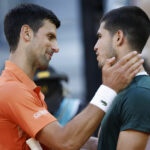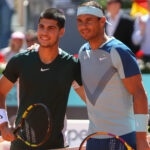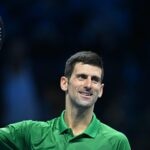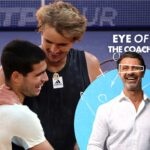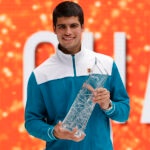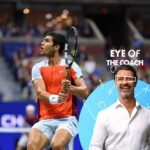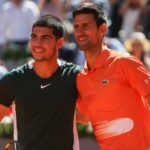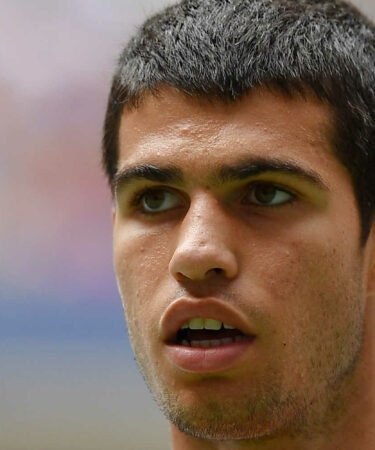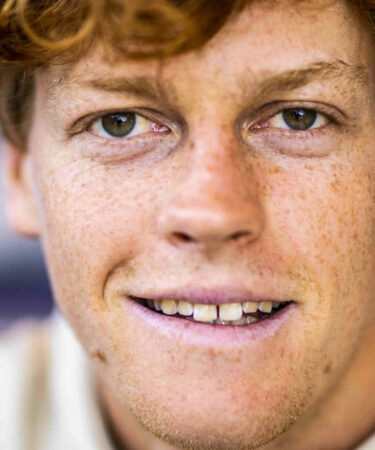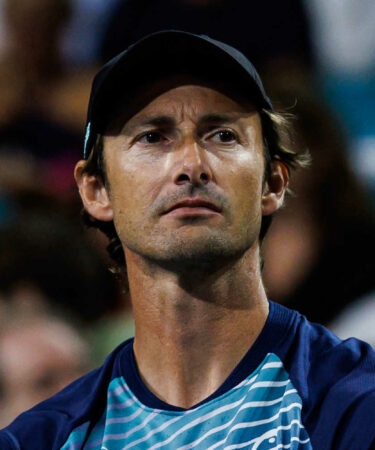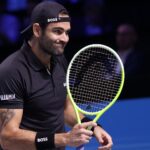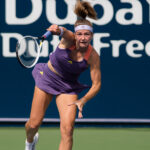From Carlitos to Alcaraz, episode 6: What next for the Spanish phenomenon and can anyone stop him from dominating the sport?
In the final part of our six-part series on Carlos Alcaraz, the youngest world No 1 in men’s tennis history, we look to the future, both his and of those who might try to challenge him
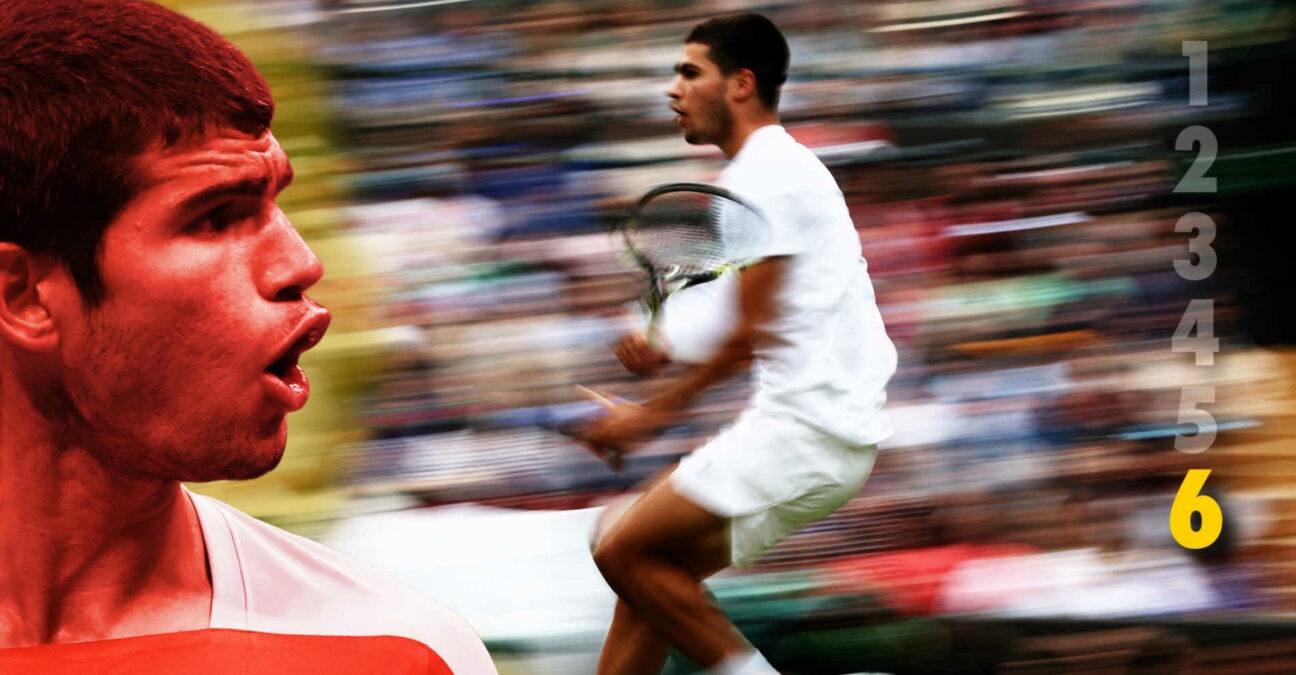 Carlos Alcaraz | © AI / Reuters / Panoramic / Tennis Majors
Carlos Alcaraz | © AI / Reuters / Panoramic / Tennis Majors
6/6: Was Carlos Alcaraz’s victory at the US Open a turning point and is he in a position to dominate the Grand Slams between now and 2025? Which players can stand in his way, why is Jannik Sinner the only contemporary with the game to threaten him, and what does everyone else have to do in order to keep the Spaniard from remaining at No 1 and winning the most slams of his generation?
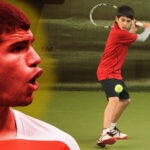
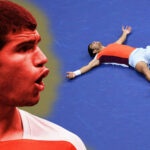


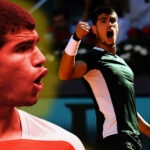
_______________________________________
We’ve seen it coming since Carlos Alcaraz was barely a teenager. In 2020, when the raw yet explosive youngster won in dramatic fashion on his ATP Tour debut in Rio – as a 16 year old! – the writing was already on the wall: Carlos Alcaraz was going to be a top pro, and the only question that remained was… how good would be become?
Two blink-and-you-missed-them years later, in the wake of his maiden major triumph at the 2022 US Open, the notion of Alcaraz as a generational player has crystalised further. In New York he passed all the examinations with flying colours and became the youngest champion at Flushing Meadows since the venerable Pete Sampras in 1990.
One day later Alcaraz capped his whirlwind star turn in style as he took his place at the top of the rankings as the ATP’s youngest world No 1 in history.
This is the part of the story that we all know well by now. What intrigues us most, at this point, are the things we do not know.
What exactly does the future of Alcaraz hold, and how has his path to greatness been accelerated by his success in New York and year-end No1 place ? Now that Alcaraz has taken flight, is anyone capable of slowing this bullet train down?
When we pooled the experts – a collection of pundits and players – for their reaction to Alcaraz’s rise, their responses were undeniably affirmative. Yes, there is something unique about Carlos. The young Pegasus in flight possesses qualities that will make him extremely difficult to beat over the years to come. Consensus conveys a strong belief in Alcaraz, while simultaneously agreeing that he has much to improve upon.
Alcaraz is nowhere near his potential yet
In other words, he’s already mind-blowing, but Alcaraz could be even better in a few years.
“You feel like he’s nowhere near where he’s gonna be probably by the time he is 22, 23,” Brad Gilbert, the former world No 4 and coach of Andre Agassi and Andy Roddick, told Tennis Majors, hinting that Alcaraz can be an even more daunting figure on tour in the not too distant future.
“I’m sure his team is thinking, ‘well, we got to improve this, this and that’, and that’s what all these good players do.”
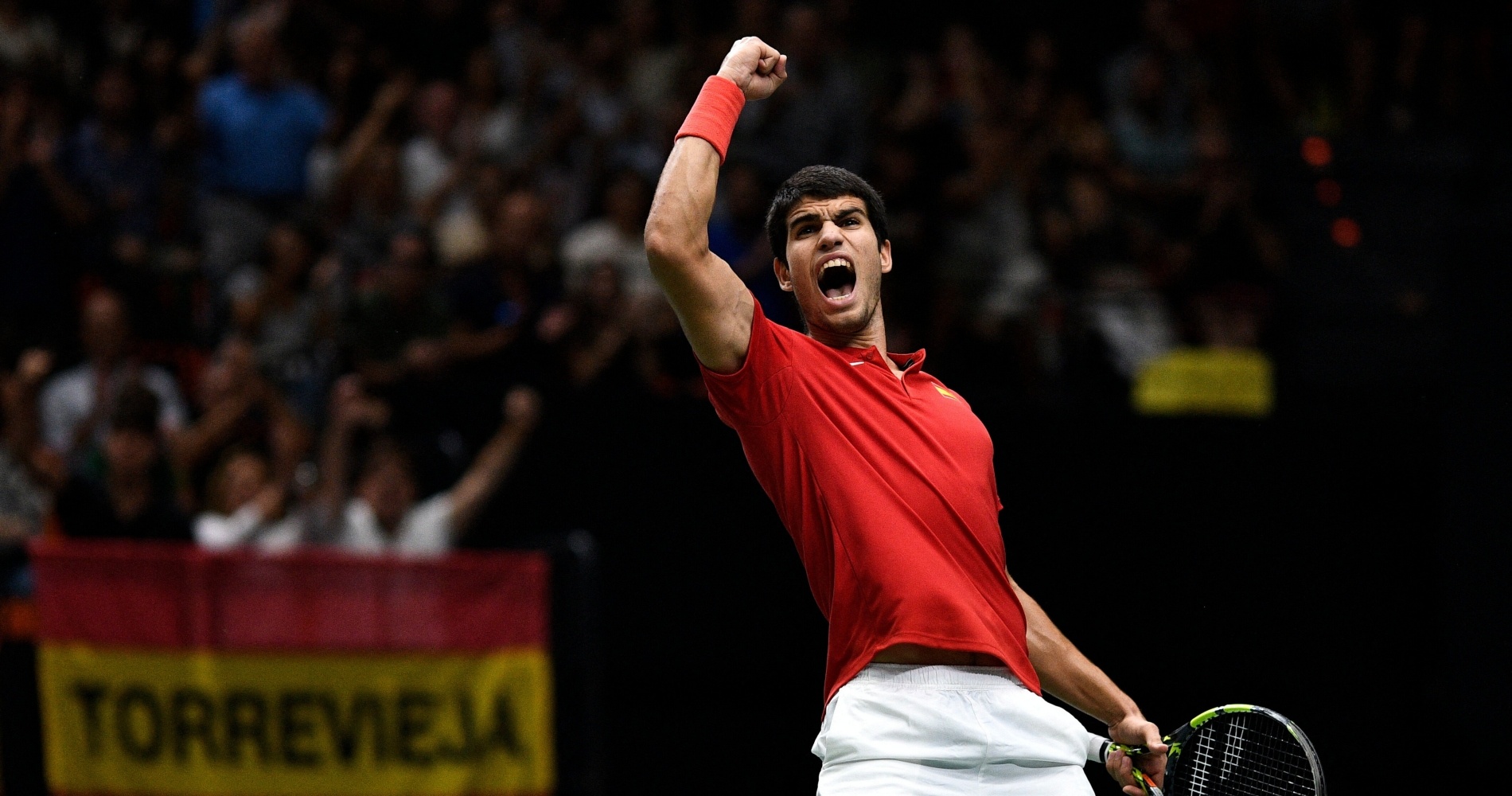
Juan Carlos Ferrero, his coach, reckons he’s only just over halfway to his potential.
“I think he’s on 60 percent of his game,” Ferrero told reporters after Alcaraz’s US Open triumph. “He can improve a lot of things. He knows and I know that we have to keep working. Once (you) get to No 1, it’s not done and you go. You have to keep working, keep playing at a huge level on those tournaments to keep winning.
“I have the goal to put him on the highest level of tennis. Of course, I think it’s going to be very, very difficult to achieve what (the Big Three) have done in tennis. We’re talking about 22 Grand Slams. He has only one. It’s a long way still to go. But who knows? I think he has all the tennis and potential to be one of the best. All we have to do is try it.”
In a recent video discussion for Tennis Majors, Patrick Mouratoglou said he feels Alcaraz is already further ahead in his development.
“I don’t want to go against Juan Carlos because he knows Carlos a million times better than me,” he said. “I’m just someone watching from the side, like all of us. But I feel like he’s more 80 percent than 60 percent of his potential. I would be very interested to know in which field Juan Carlos sees 40 percent to go because I see improvement possible, of course, but I see little things here and there in many areas, but little things. I don’t see anything big.”
Imagine an Alcaraz in, say, 2024, with a beefed-up serve, a more bullet-proof backhand, and 20 or so grass-court matches under his belt. What will the challengers do against him then?
Gilbert believes that his opponents should plan on facing not the Alcaraz they see today, but an evolved Alcaraz 2.0 that will emerge over time.
“It’s hard to say that somebody’s game was complete at 19,” he said. “The canvas is still forming and there is so much work to be done and I’m sure he’s gonna get way better.”
The most complete game of his generation
When we think of Alcaraz we don’t think of a single calling card or one booming shot that he has ridden to success in the way that Nick Kyrgios rides his serve or Casper Ruud rides his forehand. There’s a unique – some would say refreshing – quality to the Spaniard’s game that sheds light on his dedication to craft. Alcaraz doesn’t have one or two shots that he can rely on, he has all the shots.
This he has painstakingly assured through hours and hours of dedication and repetition. Alcaraz didn’t just practice as a youth. He practiced with purpose and vision, setting out on a course to create a game that had no holes.
Former ATP pro and current commentator Nick Lester is extremely impressed by what he sees from Alcaraz in that regard. He says that Alcaraz’s versatility sends a clear message to his peers on tour: Get better or get left behind.
“I think the thing that’s the most difficult for a lot of the younger guys to look at Alcaraz is just how complete he is, at the moment,” he said. “Because that’s the aspect of his game – when you’re making a side-by-side comparison with a lot of the other guys, Alcaraz’s game is already so complete.”
Lester points out that to play the way Alcaraz does as a teenager, there must have been some wisdom behind the work done in his formative years.
“Obviously part of that comes from his transitional years, his early years where he was extremely keen to kind of be that all-around player,” he says. “He was extremely comfortable moving forward in terms of his net game – that was built at a very, very young age.”
Movement? Out of this world…
All the shots in Alcaraz’s arsenal sit neatly atop a streamlined chassis that allow the Spaniard to be in place to properly time the ball and put maximum force into his groundstrokes. He routinely causes paroxysms of bewilderment in fans during his matches as he leaves skid marks on the court and tracks down balls that most players wouldn’t dare dream of retrieving.
“I have not seen a guy go from a defensive position to an offensive position as quickly as Alcaraz does”, said Lester. “And in many ways, I think you can go the other way. I think you can also say that he goes – when he has to at times – from an offensive position to a defensive position, in time that is just truly exceptional.
“His movement, his ability to slide, I think is a total game changer.”
I asked Gilbert which player was a better mover in their teenage years, Alcaraz or Nadal?
“Carlos is a better mover on hard court,” he said. “Rafa is an incredible slider, but it’s close. I mean, the guy’s movement is unbelievable. His ability to slide on hard courts is insane.”
“He moves on a hard court like he does on a clay court,” Lester said, adding: “His ability to go from a deep, defensive position to then, within a heartbeat, be up the court, and suddenly in and around the net – it’s mind-blowing. Just the manner, the skills and the unique physicality that he’s able to do that with – it’s another aspect that definitely sets him apart.”
Only Sinner and Djokovic pose a threat
Mike James describes the dilemma for everyone involved in finding options to beat him.
“Physically you are not going to compete with him, except [Jannik] Sinner, who already did it, and Novak if he backs himself up with a lot of matches,” he said.
James says that the blueprint for Alcaraz’s rivals is very much a work in progress, but he adds that even if they have drawn up the proper plan, they will have to be physically strong enough to implement it for four or five hours in best-of-five matches at the Slams.
“So how to break down Carlos’s game? I can’t share my view on this but the questions the players must ask are: do I want him to play one more shot? Two more shots? Do I want to force him to the net when he doesn’t want to come in? How do you return the serve? That’s game-specific.
“Ultimately the Big Four were able to play their game during four hours when the others couldn’t. Rafa wouldn’t have won 14 French Opens in three sets, or maybe the previous Australian Open. It’s calling the ability to adapt your game against him, but if it leads you out of your comfort zone, how long can you afford it? It’s not answered yet.”
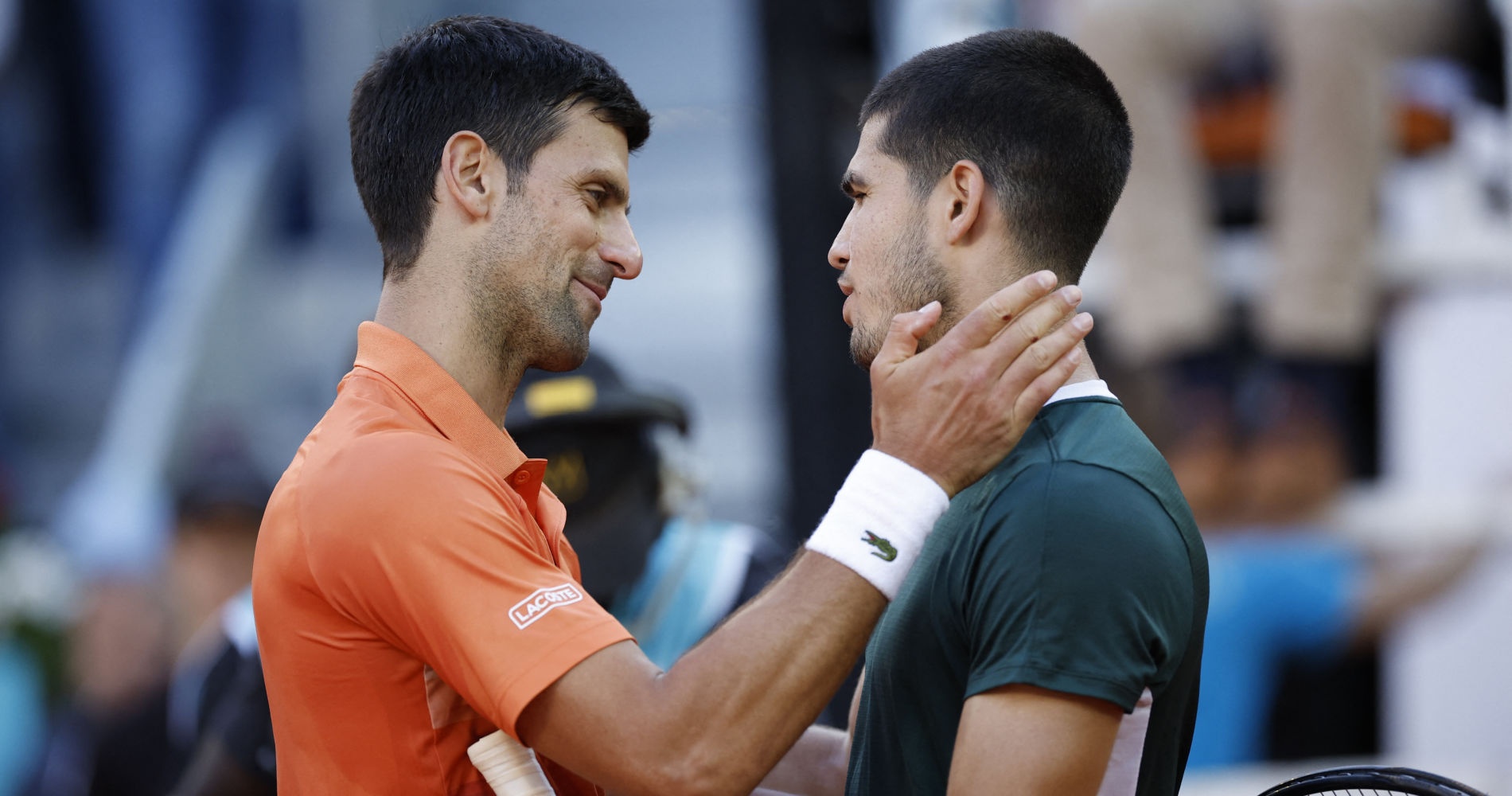
Who can challenge him, and how?
At 19, and still five months shy of his 20th birthday, most feel that he is way ahead of his peers in terms of development. The aforementioned complete game, the blazing footwork and the gargantuan forehand are all reasons that many believe Alcaraz has the potential to dominate the sport over the next five years.
Surely, 21-time Grand Slam champion Novak Djokovic will have a say about this, as will Daniil Medvedev and his contemporary Sinner, whose future seems undeniably bright.
What will it take for them to stop Alcaraz from hanging onto his No 1 ranking and racking up slam titles at the rate of one or more per season? A lot.
“If the ball goes over the net enough times, he can do quite a few more things than you can and more than likely at the end of the day he’s going to win most of those matches because of his resources and how he can actually dictate by coming forward or making you come forward or just being very consistent from the baseline or whatever it is,” renowned coach Jose Higueras, a top player in his time, said. “So unless you can actually take the racquet out of his hands, you actually have to be a better tennis player than him to beat him.”
Of course Djokovic will be there to push the young Spaniard. If we get excited about one match-up over the next few seasons, Alcaraz vs. Djokovic may be it.
“Obviously Djoker first and foremost…he’s still going to be a factor the next three, four years,” Gilbert told Tennis Majors.
Lester believes that Djokovic will be there, but isn’t sold on the fact that Djokovic will be able to run the tables against Alcaraz in the same fashion that he has against so many other rising Next Gen talents.
“Djokovic’s game is so complete, as we know,” he said. “I would still be slightly reluctant to be having Alcaraz as a favourite against Djokovic at peak, at his very best, and I think that’s a very mouthwatering prospect for next year – to see those two go head-to-head.”
Indeed.
Carlitos in the clutch
Recency bias has made Alcaraz all the rage among the critics at the moment. He has made us all believers by smashing the record books at an alarming rate for someone so young, and his coup de grâce in New York City stands as testament to not only his talents, but also his ability to maximise them under pressure.
Alcaraz has the game to be a generational talent, and he also possesses an uncanny ability to deliver his best tennis at precisely the moment it is needed most.
He is one of just seven men to win the US Open men’s singles title after saving match point. He has come back from match point down to win multiple times on tour this year, including once at Roland-Garros against Albert Ramos-Vinolas and another at Barcelona where he executed a remarkable spinning forehand winner against Alex de Minaur in the semi-finals.
Gilbert says Alcaraz reminds him of Nadal in that regard.
“I think a lot like Rafa, just his unbelievable determination, his focus, no matter what happens he keeps fighting,” he said, recalling Alcaraz’s heroics during the US Open. “Three matches in a row: down an early break against [Marin] Cilic in the fifth, down a break and in trouble, match point down against Sinner, down against Tiafoe.
“All these matches, sort of like Rafa, you always feel like it’s not over until the umpire says game, set match. It’s an incredible quality.”

Grass a challenge that can be tackled with experience
If there is a hole in Alcaraz to be poked, it is his level of play on the grass. His opponents should hurry and rapidly exploit there advantage against the Spaniard on this surface, because it might not be there long.
Alcaraz has just six tour-level matches on grass to his name and made the decision to skip the grass warm-up events in 2022 prior to Wimbledon. Nevertheless, he was able to push through to the second week before he was derailed by Sinner 6-1, 6-4, 6-7 (8), 6-3 in the round of 16.
If there is a surface where Alcaraz needs to improve, it is grass, but his lack of experience on the surface also points to the potential for rapid growth on it.
“Obviously he didn’t play on grass before,” Gilbert said. “Maybe grass will take him a second. But I get the feeling that with the guidance of his coach and the understanding of how important that tournament is, he’ll get there.”
With a complete game like Alcaraz’s, and so many tactical options, it’s almost impossible to envisage him struggling on grass for very long, if at all.
“It’s about the movement, Gilbert says. It’s about the ball bouncing lower. I expect probably next year, depending on how he does at the French, to play maybe a warm-up tournament.
“Who knows? Maybe he’s even better next year.”
“He will probably struggle against the specialists” — Gilles Cervara
Gilles Cervara, the long-time coach of Daniil Medvedev, who defeated Alcaraz at Wimbledon in 2021, predicts that Alcaraz’s arc on the grass will play out like that of Nadal. Nadal was far from a natural on the surface but managed to become one of the best. Still, he struggles to match the level of grass gurus like Federer and Djokovic.
“In general, I think his game will be less effective on grass than on hard or clay,” Cervara said. “But I think he will still be able to do well at Wimbledon like some top players of his style in the history of tennis. It will depend on the players he will meet on this surface. He will probably struggle against the specialists.”
Cervara points out that Alcaraz was not a threat to win on grass in 2021. But two years later, having evolved in so many ways as a player, he stands to be a much better player on the surface going forward.
“In 2021, Daniil played Alcaraz at Wimbledon but he was still not at the same level as he is now,” he said. “Any player is a potential danger but in this match, he was not, in all objectivity. He made a lot of mistakes, didn’t have too much experience and the quality of movement, support, and the style of shots to deliver on grass…
“Saying that, I’m sure it will be another story from 2023.”
